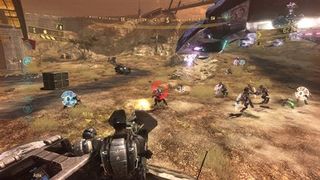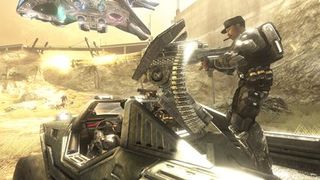With E3 Bungee’s party line changed. ODST is no longer considered a Halo 3 expansion, but a full game spread across two discs – one containing the entirety of Halo 3’s multiplayer; the other the campaign and its Horde-like Firefight mode. While it’ll be shorter than Halo 3 it’s a game you can play differently every time.

But it doesn’t take any more than a glance to see Halo 3’s old engine, which looked weathered even when Halo 3 was brand new, is looking a little tatty post Gears 2. It lacks even a semblance of the anti-aliasing which makes Gears of War look smoother than a porn star’s nut sack, and it’s obviously short of the seven hundred and twenty pees the 360 usually runs games at. Like Halo 3 it’s clocking in at around 640 lines, with the 360 upscaling it to a full 720p, which rather explains the jagged edges so sharp Jesse Ventura would use them to shave his face.
Bungie’s tech might be vastly outperformed by Epic’s Unreal 3 in sheer bloody-hell-that-looks-pretty-I-want-one-of-those stakes but it’s not many devs who can rival Bungie’s sense of design. Those vaguely crummy-looking graphics are the reason we were able to go to war against two Covenant Scarabs on land and in the air while an entire war raged around us at the climax of Halo 3’s Journey’s End mission.
The old Halo engine doesn’t photograph as well as its modern counterparts then, but it does everything Bungie needs and handles everything gamers love flawlessly – massive environments filled with massive stuff, and entire armies going to war in a vaguely intelligent fashion. ODST might be shorter than Halo 3, but it’ll be a whole lot wider too.

The linear missions will be precisely as good as you’d expect from the Haloverse but it’s almost disappointing that Bungie didn’t have the nerve to dispense with them altogether. Halo combat evidently works sandbox-style, even with an ODST fighter’s obvious weaknesses – while we’re mightily impressed with Bungie; you’d never know it’s their first shot at a truly open world.
Jul 15, 2009
